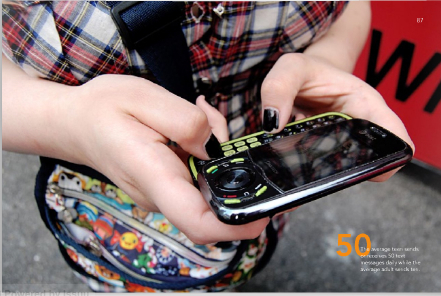In certain teen social circles, it’s considered a subtle act of arrogance, a signifier of the loner, to use a solo photo of yourself for your Facebook profile. Digital natives may have earned their reputation as the “entitlement generation,” but apparently there are some social limits to their unabashed self-regard.
In fact, there’s compelling evidence the up-and-coming cohort of young Americans has grown increasingly sophisticated in navigating the public-by-default scene of social networks. Researchers say they are evolving forms of social coding to signal to each other while at the same time keeping their thoughts, activities and personal communications masked from older generations.
For example, profile photos that include friends may have originated as a safety mechanism, according to Danah Boyd, a researcher that specializes in the intersections between technology and society at Harvard’s Center for Internet and Society, but now are a “social signal that you are sociable.”
Though social media has expanded well beyond the youth demographic — 20 percent of Facebook users are aged 45 or older — the front lines of cultural-technological change are predominately filled by the young. This is, ultimately, their world. The rest of us are just visiting.
Given their numbers — 82 million Americans were born between 1980 and 2000 — and their reputation for strong opinions, the buying clout of Gen Y consumers could surpass all previous generations.
The Badge of Brands
The Gen Y relationship to brands is part of a broader shift in social norms ushered in by digital communications. When young people choose to “like” a brand on Facebook, they’re essentially putting on a badge that helps define them among their peers. Online brand fandom can be viewed as a performance, part of a carefully calibrated process to craft and project a personal identity that transcends public and private selves.
“Even when people really lock down their privacy settings on Facebook, one of the things they don’t hide is what brands they like,” explained Peter Swanson, a college-aged intern at our ad agency, Engauge, whom we regularly interrogate on Gen Y social protocols. “I know it sounds superficial, but if I see a girl likes three or four brands, I pretty much know who she is — or at least, I can tell if we’re going to click, if we’ve got a chance. If she likes J. Crew, right? Or, like, Old Navy? That says a lot.”
Coded Messages
Conscious brand identification can be exercised online by more mature demographics, but the critical difference is that teens appear more naturally attuned to the subtlest of social signals online.
Having been raised in the digital slipstream, they’re highly sensitive to its shifting currents. That’s both good news and bad news for marketers. On one hand, positive and public brand associations can generate significant value for brands.
But, on the other hand, as the industry moves inexorably toward more sophisticated behavioral marketing, there are signals that teens are adopting practices to remain unknowable and inscrutable.
One of the ways that teenagers have adapted to the open social architecture of online networks is by increasingly coding their public messages in private language — song lyrics, personal jokes — that’s decipherable only to those friends who are the intended recipients of the message.
This “social coding” can effectively keep nosy parents, college admissions officers and future employers in the dark. This doesn’t mean they’re scrubbing every detail from their public personas.
“Teens turn to private messages or texting or other forms of communication for intimate interactions, but they don’t care enough about certain information to put the effort into locking it down,” said Boyd, the Harvard researcher, when addressing the international convention on privacy and data protection last October. “But this isn’t because they don’t care about privacy. This is because they don’t think that what they’re saying really matters all that much to anyone.”
The average teen sends or receives 50 text messages daily, according to Pew Internet. Over 30 percent of teens send more than 100 texts, and 15 percent send more than 200. (The average adult sends 10.)
Interestingly, Twitter is now emerging as a favored channel for private communication among the most popular and tech-sophisticated teens in high-income American communities. Boyd has observed that these teens tend to protect their Twitter accounts, making them accessible only to a subset of friends. This also relieves them from too much traffic on Facebook. “Facebook is like shouting in a crowd, Twitter is like talking in a room,” one teen she studied said.
This all seems counter-intuitive to the older Twitter demographic, which is steeped in the traditions of mass media and eager to broadcast messages to the widest possible audience.
As digital natives mature, their public presence and behavior on social networks will evolve, impacting broader social norms. The expansion of these new social codes may require a rewrite of the prevailing narrative of digital natives as self-absorbed narcissists unconcerned about privacy. And wouldn’t that be a nice surprise.
Mya Frazier is director of trends and insights at Engauge, one of the nation’s largest independent advertising agencies. This article is adapted from the Engauge 2011 Digital Outlook, a comprehensive report on the future of marketing in the digital era.
As the advertising correspondent for MediaShift, she chronicles the impact of digital, mobile and social marketing trends on content, culture and commerce. A former business journalist, she has been a staff writer at Advertising Age, the Cleveland Plain Dealer and American City Business Journals. You can follow her on Twitter.

